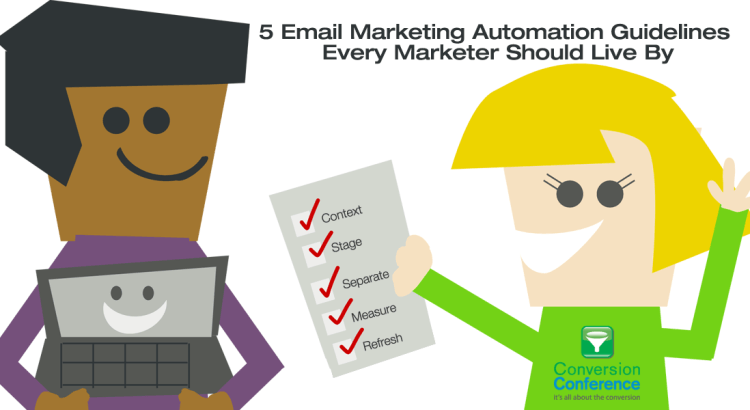Kicking off a drip nurturing campaign? Creating an auto responder email to go out when a form is submitted? Great! But before diving in and automating the processes take a minute to consider some simple but very important email automation guidelines.
When automating communication with customers, leads, or other parties there are certain rules of thumb that go beyond the basic email etiquette most marketers have permanently ingrained in their brains. So once you’ve checked all those essential email best practices (grammar and spelling check, enticing subject line, etc.) off your list, keep in mind this second set of standards before setting the automation wheels in motion.
1) Context – Ensure your content will make sense to the recipient receiving the email. For example, if your company deals with multiple client industries, set it up so that industry information is recorded and segmented recipient lists are kept so that tailored, applicable information will be sent to your contacts.
2) Stage – Piggy backing off the previous point about context is being mindful of the different sales stages your contacts may be in. Content you normally send to someone at the beginning of a sales cycle is very likely to look different from what would be sent to someone well into the consideration stage. This practice should be reflected in your automated campaigns as well. Automation rules based on sales stage or lead scoring can be very helpful in ensuring that the right content gets to the your contacts.
Ready for More Conversion-Boosting Tips?
Join the worldwide community of conversion optimizers at ConvCon 2017!
3) Separate – Have a standard email template that can be used in multiple campaigns? Good! But keep this email separate (meaning create multiple versions of the same email) to see how it performs across each individual campaign. You may see that it works well for one recipient group, but has a poor open rate for another – data that would be nearly impossible to collect if just one template were used in multiple campaigns.
4) Measure – Take a look at your email stats (open rates, click throughs, etc.) regularly to see which emails are performing well and which could be doing better. Also, drawing conclusions about what works from your top-performing content and applying it to other emails can help you to draw further conclusions about what types of messaging and calls to action work best for your contact base.
5) Refresh – Measuring your email stats is great, but make sure to revisit the actual email content as well to keep it current. Eventually you may find an email has become a bit tired or outdated, or maybe you just produced a new, great piece of content that could be added into an email that was starting to lose steam. Although these rules may seem daunting at first, keep in mind that most of the work for email marketing automation takes place in the initial stage and that the devil is often in the details. Once the set up has been thought through it can run like a well-oiled machine, only needing occasional tweaks or revisions.
This post originally appeared on the Cheshire Impact Marketing Blog.
About the Author
 A salty, seasoned marketer from the battlefields of CTR and CPA, Casey Cheshire is the founder and Chief Awesome Officer of Cheshire Impact, the largest and most recommend Preferred Partner of marketing automation platform, Pardot. With an aptitude for building and managing effective teams, Casey has enjoyed repeated success leading, growing, and optimizing lead generation and e-commerce initiatives for highly visible online properties. Prior to founding Cheshire Impact, he served as VP of Marketing for Sesame Software, Director of Marketing for C2FO, a global collaborative exchange for working capital, and in numerous other marketing roles. He was a team member with the US Marine Corp, responsible for mission accomplishment, team safety and mentoring while the team was deployed to Iraq in 2006. Casey is an avid mountaineer, a skydiver, and a Tuangou evangelist.
A salty, seasoned marketer from the battlefields of CTR and CPA, Casey Cheshire is the founder and Chief Awesome Officer of Cheshire Impact, the largest and most recommend Preferred Partner of marketing automation platform, Pardot. With an aptitude for building and managing effective teams, Casey has enjoyed repeated success leading, growing, and optimizing lead generation and e-commerce initiatives for highly visible online properties. Prior to founding Cheshire Impact, he served as VP of Marketing for Sesame Software, Director of Marketing for C2FO, a global collaborative exchange for working capital, and in numerous other marketing roles. He was a team member with the US Marine Corp, responsible for mission accomplishment, team safety and mentoring while the team was deployed to Iraq in 2006. Casey is an avid mountaineer, a skydiver, and a Tuangou evangelist.

 717 798 3495
717 798 3495



